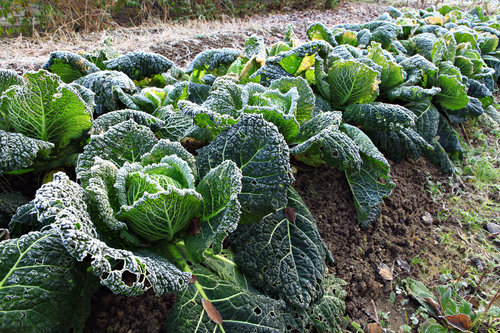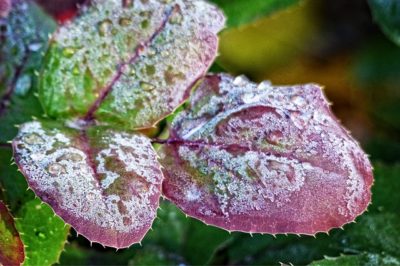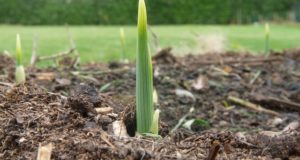Every spring when the first spell of warm weather occurs, many beginning gardeners head to their local garden centers and nurseries, eager to get planting. When the temperatures rise and the sun is shining, it is tempting to want to get a head start on your spring garden.
However, that head start can be a frustrating waste of time and money when spring frost damages or destroys your young plants. You can avoid this scenario by doing a little homework on frost and freeze dates in your area.
First, what exactly is frost? By definition, frost is a collection of tiny white ice crystals that form on the ground or other solid surfaces when the air temperature gets cold.
Frost forms when water vapor in the air changes from the gas phase to the solid stage. Frost is difficult to predict, though, because the air temperature within the vicinity of your garden can be several degrees higher than 32 degrees Fahrenheit – the freeze point — and yet it can still form on your plants. As a result, the National Weather Service uses 36 degrees Fahrenheit and below as its guideline for a possible frost. But even then, frost may not occur. The air must be mostly still, and moisture has to be in the air. (A frost is different from a freeze, in which the temperature must be 32 or below.)
Seamazing: The Low-Cost Way To Re-mineralize Your Soil
Frost can damage plants by causing ice crystals to form in the plant cells, disrupting the movement of fluids to plant tissues. Frost-damaged leaves first appear water-soaked; then they shrivel and turn dark in color.
Garden plants are classified according to the temperatures they can usually tolerate. Plants classified as “hardy” can tolerate some frost, while plants classified as “tender” often are killed or damaged by frost.
The average last spring frost date usually ranges from mid-March to mid-May, depending on where you live in the United States. Almanacs, websites and university extension services often take historical data into consideration and list an average date as the last frost date.
Many seed and gardening websites feature last frost dates that you can look up by typing in your zip code. Keep in mind, however, that that date is an average, and that means that a frost can certainly occur after that date.
The location of your garden can play a big factor in whether your plants are damaged by a frost or not. Generally, air temperature lowers from 3-5 degrees Fahrenheit with each thousand-foot increase in altitude. Therefore, the higher the elevation of your garden, the more likely your plants will be hit by a frost or freeze. On the other hand, cold air is heavier than warm air and can sink to lower areas, causing frost damage.
The best spot for an early annual garden is on a gentle, south-facing slope that is exposed to plenty of late-afternoon sun and is protected from the north wind. A garden that is surrounded by trees, shrubs or buildings or is located near a body of water is also less likely to be damaged by frost. Additionally, closely spaced plants can protect each other from frost damage.
The best way to prepare for a late-season frost is to know the sensitivity level of your plants. In addition, the plant itself can give you clues. Immature plants that still had new growth showing well into the fall are susceptible to damage. Plants with dark-colored leaves – especially bronze or maroon – absorb and retain heat and can better handle a frost. Also, in general, plants that are compact have less to expose to the cold and wind and therefore can ride out a frost better than taller plants with smaller leaves.
Get The Best Deals On Non-GMO Seeds For Your Garden Right Here!
What should you do if you have planted your garden and learn that a frost is likely? Here are a few tips:
- Cover your plants to retain soil heat and moisture and to protect them from strong winds. You can use newspapers, fabric tarps, sheets, straw or baskets, but be sure to cover the entire plant in order to trap any heat. Anchor lightweight coverings to prevent them from blowing away. Avoid plastic covers because, unless you remove them quickly enough in the morning, they can create enough heat in the morning sun that will actually burn your plants.
- Water your plants if frost is predicted. It may seem counter-intuitive, but as the water freezes, it will release heat, protecting the plants from damage.
- If you are able to use an electric fan to protect your plants from the elements, then set one up by your garden. Even a small breeze can help stop cold air from settling on your plants and then freezing during the night.
- Potted plants are susceptible to frosts because their roots are less insulated. Move smaller pots indoors or under a cover. If the planters are too big to move, wrap the pots in burlap or bubble wrap or try burying the pot in the ground. Also, place a covering over the foliage.
As you plan your spring garden, realize that in late April or early May, you are not out of the woods for a spring frost. If your green thumb cannot wait and you are a bit of a risk taker, you still can have gardening success as long as you watch the weather carefully and prepare for the worst.
Related:
Tricks And Secrets To Keep Rabbits From Destroying Your Garden
How do you protect your garden from frosts? Which vegetables do you plant the earliest? Share your tips in the section below:
Every Spring, Gardeners Make This Avoidable Mistake — But You Don’t Have To. Read More Here.
 Off The Grid News Better Ideas For Off The Grid Living
Off The Grid News Better Ideas For Off The Grid Living





